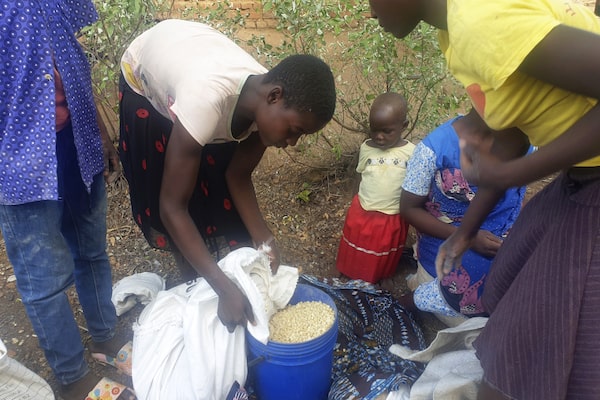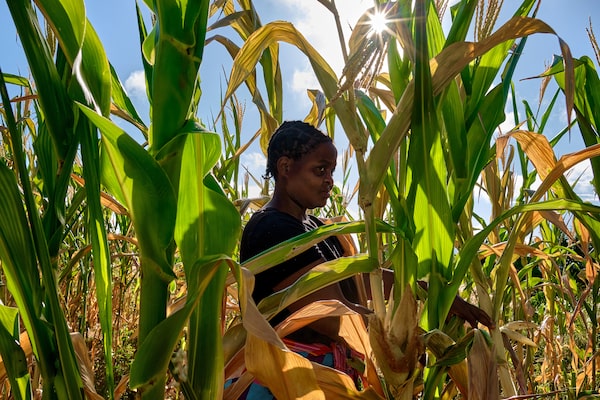
A woman receives maize meal at a United Nations World Food Programme distribution centre in Neno district, southern Malawi on March 24.Kenneth Jali/The Associated Press
Chengetai Nyamhunga is on a constant search for food. He trudges from neighbour to neighbour, from shop to shop, hoping to find maize at a price he can afford. Often he begs for just a cup of maize meal, so that his family will not starve.
Maize meal is the staple food for most Zimbabweans, but a worsening drought has triggered a doubling of its price over the past few months, forcing Mr. Nyamhunga to cut back on his family’s meals. Instead of having the ground maize three times a day, now they can afford it only at night.
“The people with maize stored in their homes are making it very expensive for us,” said Mr. Nyamhunga, 47, who earns a living by mending tires and shoes in a low-income district of Zimbabwe’s capital, Harare.
“They often refuse to sell it,” he said, standing in a queue at an informal shop where he hoped to find maize meal at an affordable price. “I’m very angry at these high prices. They know we are desperate.”
Across much of Africa, food prices are soaring and hunger is rising. In southern Africa, drought and climate change are leading to crop failures and higher inflation. In countries such as Sudan, Ethiopia, Niger, Burkina Faso, Mali and the Democratic Republic of the Congo, war and conflict are making food much scarcer and costlier, and malnutrition is growing. Humanitarian agencies are trying to help, but their budgets are squeezed.

Early warning hunger hot spots
November, 2023, to April, 2024
Hots pots of
highest concern
Hot spots of very
high concern
Hots pots
REGIONAL RISK
Burkina Faso
and Mali
Sudan
Djibouti
Somalia
Ethiopia
Niger
South Sudan
Chad
Zambia*
Democratic Republic
of the Congo
Malawi
Zimbabwe
*Zambia has emerged as a hunger hot spot this year
the globe and mail, Source: u.n. world food program

Early warning hunger hot spots
November, 2023, to April, 2024
Hot spots of
highest concern
Hot spots of very
high concern
Hot spots
REGIONAL RISK
Burkina Faso
and Mali
Sudan
Djibouti
Somalia
Ethiopia
Niger
South Sudan
Chad
Zambia*
Democratic Republic
of the Congo
Malawi
Zimbabwe
*Zambia has emerged as a hunger hot spot this year
the globe and mail, Source: u.n. world food program

Early warning hunger hot spots
November, 2023, to April, 2024
Hot spots of
highest concern
Hot spots of very
high concern
Hot spots
REGIONAL RISK
Burkina Faso
and Mali
Sudan
Djibouti
Somalia
Ethiopia
Niger
South Sudan
Chad
Zambia*
Democratic Republic
of the Congo
Malawi
Zimbabwe
*Zambia has emerged as a hunger hot spot this year
the globe and mail, Source: u.n. world food program
Zimbabwe, Zambia and Malawi have all declared a state of disaster this year, in response to droughts fuelled by El Niño weather conditions and intensified by climate change. More than 20 million people in southern Africa are facing hunger, according to a new report by Oxfam. The drought extends as far as Botswana, Angola, Mozambique and Madagascar.
In Zimbabwe, the maize harvest is expected to fall by 50 per cent this year, forcing 2.7 million people to rely on emergency aid. The crisis is compounded by tax increases, a deteriorating currency and an economy in near collapse. Zimbabwe has the world’s second-highest food inflation rate, reaching 26 per cent this year, the World Bank says.
“People selling maize from their homes were now withholding it, saying they fear hunger if they sell all of it,” said 26-year-old Nomsa Mpofu, a vendor making fried potatoes by the roadside in a Harare suburb.
“We are five in our family and now we eat only once a day,” she said.
Villagers collect their monthly allocations of food aid provided by the World Food Program in Mumijo, Buhera district, east of the capital Harare, Zimbabwe on March 16.Philimon Bulawayo/Reuters
In Zambia, maize prices in some regions are nearly double the five-year average, according to a report by ACAPS, an independent humanitarian analysis group. Drought has destroyed about a million hectares of maize – almost half of the country’s maize under cultivation.
“This has increased food prices across all Zambian provinces and decreased the availability of affordable food items, worsening food insecurity for millions of people across the country,” the report said.
More than six million people are now at risk of acute food shortages and malnutrition, the report said. In the Zambian capital, Lusaka, many people say that the soaring price of maize meal – known as mielie meal – has forced them to cut back on what they eat.
“I don’t know when we last had breakfast at our home,’’ said Bradford Nyoni, a 28-year-old unemployed teacher. “There is suffering going on. Many families are forced to go without meals due to the unaffordable food prices.”
Some people, he said, have resorted to drinking local beer made from millet or sorghum in the mistaken belief that this could be a substitute for the maize they cannot afford.
In the city’s shops, the rising food prices often spark arguments between shopkeepers and customers. Some traders have reduced their package sizes to avoid hiking their prices. A number of restaurants have closed.
“Mielie meal is too expensive for the majority of people,” said Jonas Lwinbi, who sells rubber stamps at a street stall in Lusaka. “The government should think of importing maize, before we have runaway prices which no one can afford.”
In Malawi, maize prices have nearly doubled in the past year, pushing up to 40 per cent of the population into hunger and leaving two million people in need of emergency assistance. “The impact is huge, and so are the needs,” Paul Turnbull, the World Food Programme director in Malawi, said in a statement this month.

Ladias Konje, a communal farmer, walks through her wilting maize field, which suffered from moisture stress at tasseling during a long mid-season dry spell, in the Kanyemba village in Rushinga, Zimbabwe, on March 3.JEKESAI NJIKIZANA/Getty Images
In a normal year, these countries could turn to South Africa for help, since it usually exports much of its maize harvest to neighbouring countries. But this year, the drought has damaged South Africa’s production too. Its maize harvest is expected to drop by about 20 per cent. White maize future prices in South Africa have climbed by about 25 per cent in the past year, and the country is unlikely to have much of a surplus to export.
The crisis is far worse in war zones such as Sudan, where cereal prices have doubled and malnutrition is soaring because of the conflict that erupted a year ago, or in eastern Congo, where food prices have escalated in the city of Goma as rebel fighters besiege it. In Ethiopia, maize prices are still far above normal, partly because of years of regional wars that severed trade links to larger cities.
Canadian Foodgrains Bank, a partnership of 15 churches and church agencies, says its partners in many African countries have reported sharp increases in the cost of food supplies over the past three years, complicating their humanitarian work and forcing tough decisions on how to adjust their food parcels.
“Hunger drives conflict and conflict drives hunger,” Andy Harrington, the group’s executive director, said in a commentary this week. “It destroys crops and stored grain. It disrupts food production and trade.”
He quoted one of the group’s partners in eastern Congo, Flori Bwami, who said: “There’s no peace without bread.”
 Geoffrey York
Geoffrey York